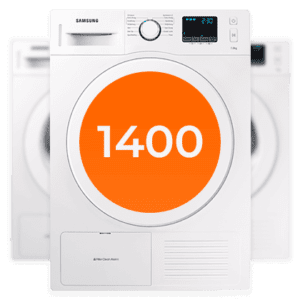Washing machine with 1400 RPM
First of all, we would like to answer the question ‘what is a RPM?‘ The RPM of a washing machine indicates how many rounds the drum makes per minute while it is spinning. The higher the spin speed, the drier your laundry will be. Washing machines that spin at 1400 rpm are classed as ‘high rpm’. This means that your laundry comes out significantly drier, which is great if you don’t have a tumble dryer and have to let your clothes and bedding air dry.
The range of washing machines that come with 1400 rpm is very large. Most washing machines on the market today make 1400 rpm. In second place – by far – are washers that make 1600 rpm. Higher rpm will make your laundry slightly drier. Choose a 1600 rpm washing machine if you want your laundry to be as dry as possible – with a residual moisture content of 44%. Washing machines that run at 1400 rpm have a residual moisture content of 50%.
If you don’t care about rpm, for example because you are using the dryer anyway, you could also look at washing machines that spin at 1200 rpm or less. However, there are not many of these as most new washing machines have high RPMs.
Best washing machines with 1400 RPM of 2024
If you are looking for a 1400 rpm washing machine, you’ve come to the right place! We have put together the best washing machines with a high number of revolutions. We have compared many washing machines on the basis of their fill weight, noise level, the various wash programmes, energy class and customer ratings. These are the best 1400 rpm washing machines of 2024!
Buying 1400 RPM washing machines; what to look for?
RPM is very important when picking a washing machine, but of course, there are many other things to look for when buying a new washing machine. Washing machines are complicated devices with many different aspects and specifications. Here is what to look for when buying a high speed washing machine.
Type of washing machine
There are 2 different types of washing machines: the front loading and the top loading. The front loading washer is the most common and the most popular. It has the door at the front of the drum so you have room on top of the washer to add a dryer. The top loader has the door at the top. These models are often smaller and higher, so you don’t have to bend over as much. Both types of washers are available with a 1400 RPM, but a top loading model is harder to find.
Fill Weight
The fill weight of a washing machine indicates how many pounds of laundry will fit in the drum. This is also known as the capacity of the washing machine. Exactly how much fill weight you need depends on several aspects, but the size of your household plays the biggest role. If you’re a one or two person household, you should choose a 6kg or 7kg washing machine. If you have 3 or 4 people, an 8kg machine would be better. If you have a household of 5 or more, you should look at washing machines with a 9kg or 10kg fill weight. Other reasons to go for more capacity might be because you exercise a lot or wash more frequently due to an allergy.
Energy Class
The energy class, also known as energy label, indicates how energy efficient a washing machine is. This is usually not at the expense of the speed, as this uses less energy than you might think. Most of the energy consumed by washing machines is used to heat the water – and that’s where the manufacturers of washing machines save energy. Washing machines are getting more energy efficient – which is good for the environment and good for your energy bill. Often, energy-efficient machines are more expensive to buy, but they save you money on consumption. For energy-efficient washing you should look at A, B or C rated machines, with A being the most energy efficient.
Centrifugation Noise Level
Depending on where you place your new washing machine, the noise level is very important. During the spin cycle, washing machines can be quite noisy. However, this is not directly related to a higher 1400 rpm speed. There are several reasons why some washing machines make more noise than others, including the type of motor used, the quality of the materials used and whether the machine has dampers. Will your new washing machine be installed in the attic or the shed? Then it’s best to choose a louder washing machine. But will it be installed in your bathroom, kitchen or a room next to a bedroom? Then we recommend that you choose a quiet washing machine. The noise level of a washing machine is measured in decibels (dB). 78 dB or more is considered loud, 74 dB to 77 dB is considered normal, 72 dB and 73 dB is considered quiet, and 71 dB and below is considered extra quiet.
Ease of Use
Washers are offering more and more options to make washing easier for you. These include a load sensor, delayed start, adding wash in between (addwash), a self-cleaning detergent drawer, automatic detergent dosing and control via an app. Do you think you could benefit from all this while doing your laundry?
Wash programs
There are an infinite number of different wash programs, and that’s because everyone needs something different. If you have a need for certain wash cycles, due to the composition of your household for example, make sure that the washing machine you buy actually offers them. There are special programmes for delicate fabrics, stains, sportswear, baby clothes, extra hygienic washing and shirts, among others. Be aware, however, that the high 1400 rpm can often only be used for cotton laundry programmes.
Preferences and disadvantages 1400 rpm
Everything has its advantages and disadvantages.
Benefits
Your laundry gets relatively dry and has a residual moisture percentage of only 44%. This gives you the choice of hanging your laundry out to air dry, or putting it in the dryer. Your dryer won’t have to work as hard to get your laundry completely dry – which makes a difference because it’s less energy-efficient than your washing machine. The dryer uses a lot of energy, which is bad for the environment and will show up on your energy bill. Also, clothes don’t last as long when you put them in the dryer. This is why it is often better to let the clothes air-dry, which can also be done after washing them in a 1400-rpm washing machine.
Also, your laundry will come out of the drum less wrinkled than with a 1600-rpm washing machine.
And finally, you have an incredible amount of choice! The majority of washers sold today run at 1400 rpm.
Disadvantages
Your laundry will not be as dry as a 1600 rpm washer during the spin cycle.
If you choose a washing machine with a lower rpm, for example 1200 rpm, your energy consumption will be lower and you will have less wrinkles in your clothes.

